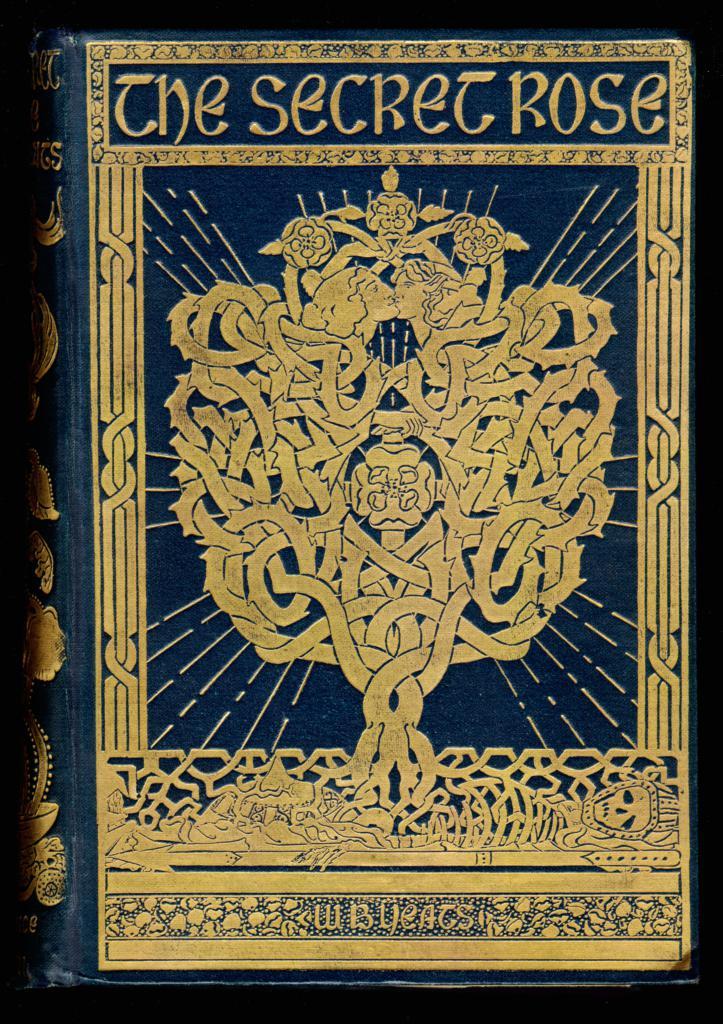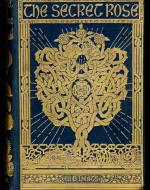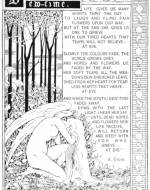Created by Aoife Keefe on Thu, 03/21/2024 - 12:02
Description:
Althea Gyles: Irish Poet, Book Designer, and Illustrator
Althea Gyles (1868-1949) is an Anglo-Irish creative. She is best known for her close friendship and work done for Irish poet W.B. Yeats, having designed the first edition covers for his The Secret Rose (1897), Poems (1899), and The Wind Among the Reeds (1899). Literature and academia are lacking on the subject of Gyles with almost anything about her being connected back to the men in her life: Yeats’s puzzling friendship, her admiration of Oscar Wilde and her illustrations for his poem “Harlot House” (1904), her various complicated and exaggerated affairs and flings. It seems as though Gyles as a public figure suffered from some of the same critical fates that female poets like Sylvia Plath and Anne Sexton were subjected to: usually an overly critical, male-centered, sensationalized image of the depressed, mad, female poet— this time, in the Victorian era.
Arianna Antonielli, the author of one of the only scholarly articles on Gyles, seems to similarly paint a rather flat image of Gyles; she describes Gyles biographically as an object of sympathetic mockery by Yeats, a messy and “strange red-haired girl” with a “mysterious temperament, but also caused by a miserable existence and occult disposition.” Antonielli details her affairs, particularly one with scandalous literary pornographer Leonard Smithers, a liaison that ended her friendship with Yeats. Simon Cooke seemingly offers a more rounded exploration of her work and thankfully focuses less on the artist’s relationships. This exhibit works to undo the one-dimensional, scandalized biographies of Gyles and her artistic endeavors. The case begins with one of the only surviving pictures of Gyles, seated next to an Irish revolutionist and suffragette, providing a personal view into her parlor. Then, we move from the most popular to the most intimate, starting with her book design for Yeats’s The Secret Rose, the introduction to her highly symbolic, esoteric yet highly regarded art. Then, we move to a more simple work in her career, the simple yet decadent cover for Ernest Dowson's Decorations In Verse and Poetry (1899), encapsulating poetry that Gyles was often moved and inspired by. Finally, the exhibit ends with Gyles’s illustration of her own poem, “Dewtime” (1894), a culminating moment that provides a deeply intimate view into the misunderstood, over-critiqued female poet and artist.
Althea Gyles, Cover for W.B. Yeats's The Secret Rose, 1897, from "Althea Gyles as a Book Cover Designer," The Victorian Web, scanned by Simon Cooke. It is seemingly impossible for Althea Gyles to be detached from the work she did for Irish poet W.B. Yeats. Gyles completed book covers and bindings for four of the poet’s collections, but it is The Secret Rose (1897) that today stands as the most famous for the artist. The binding, alongside the other covers in her collection, is extravagant and distinctly Celtic: an intricate arabesque depicting a thorned rose bush centering a bloomed rose over a cross at the heart of the bramble, the heads of two loves blooming from the branches and kissing, three small roses make up their crown. Below, a skeleton lies in a hidden tomb, his bones mangled and becoming the roots that birth the glowing bush with glinting lines radiating from it. The cover is framed like an altarpiece and depicts ornate patterns and detail within the borders, small flowers enveloping the title and author name, and braided knots on the left and right sides. Almost the entire cover is symmetrical, a call to the iconography the occultist group both Gyles and Yeats were tied to, the Golden Dawn, which guarded patterns and geometry as spiritual; the use of pattern, symmetry, and complex geometry in Gyles’s covers for Yeats reflects the spirituality of the poems within The Secret Rose and forms a repeating motif to reflect the poet's often organic and pastoral imagery— the abstracted Irish countryside, the rose and its thorn as motifs of life and pain, the recurrence and perpetuity of nature. Book covers are a slanted form of illustration, as they serve a different, more direct purpose; Gyles forms a connection not only between work and reader but work and viewer as well— hopefully, the reader-viewer will be drawn in by the ornate, beautiful gold design and read the short, Irish mythologies that lurk inside.
Althea Gyles, Cover for Ernest Dowson's Decorations In Verse and Poetry (1899), Abebooks.com. Yeats once called Gyles’s “central symbol” the rose. The symbol is centered both literally and personally for Gyles, as she features the rose motif in half of her book designs for Yeats and perhaps most simply in her cover for Ernest Dowson’s Decorations in Verse and Prose (1899). Dowson was part of the late Victorian era decadence movement and was probably drawn to Gyles for her relationships with writers like Yeats, Oscar Wilde, and illustrator Aubrey Beardsley, all of whom were associated with the Decadance movement (Cooke 86). Gyles was both artistically and poetically inspired by the poet’s tonal melancholic weariness often communicated through fantastic and esoteric experiences of nature, love, and loss (Antonelli 281-283). It seems only right that the cover for Decorations would feature the rose motif, a symbol used by both her and Dowson frequently. The cover is white and leatherbound, featuring again a gilded flower as the central design. The rose’s thorned stem swoops from the bottom right to the flower in the top left; the stem splinters from the bottom and forms a bud that intersects the middle of the rose’s leg, representing the creation of new life. The design is ornate and decadent, bordered by two gold-lined frames, featuring a quatrefoil in the corners. The only words on the cover are the shortened title, Decorations, tucked underneath the flower with long flowing lines branching from the “R” and the “S,” congruent to the swooping stems above it. Gyles’s design seems an apt cover for the poetry collection it contains, as it is simultaneously ornate and simple, lamenting loss and preserving the loveliness and beauty of the blossoming rose.
Althea Gyles, "Dewtime" (1894), from The Victorian Web, scanned by Simon Cooke. It is Gyles’ 1894 “Dewtime” that provides the modern viewer with the most personal work from the artist. One of her only surviving pieces not linked to another writer, Gyles's "Dewtime, which she illustrates, appears as a Decadent-style piece. The work is self-contained, featuring borders of flower petals on the right, a blossomed crown of roses next to the ornate title “Dewtime” under beams of sun. The bottom features a panel of roots that reach into the grass, leaves, and mushroom-covered loam of illustration. The tendrils of plants are tangled with the long, flowing hair of a nude, winged angel, who weeps over her arm, kneeling in this earthly valley. The thin, looming trees above her wings seemingly grow up forever, slightly covering a vast and cloud-speckled sky. The angel is oblivious to the text to her right, the three stanzas that depict what one assumes is her own despair, as she instead looks towards the ground, the “dew drenched leave,/ shed from her heart for tear/ less hearts that heave —/ at eve.” The ending is a repeating refrain, making the angel seem trapped in a never-ending “eve,” which she admits to herself in the final stanza, “Until dead hopes/ and flowers new/ life receive,/ I will return/ and weep with/ you who/ grieve — / at eve.” Gyles’s “Dewtime” is a work of illustration and poetry in conversation with one another, and it is impossible to tell which came first; the result of this is an infinite entanglement between the two, a haunting expression of despair and depression, which congruently plagued the artist-poet’s life.
Althea Gyles, circa 1902, from "Althea Gyles," Transpontine.com. One of the only surviving photos of Gyles, circa 1902. She relaxes in a messy parlor, a cigarette in her hand, sitting across from Irish revolutionist Constance Markiewicz (1868-1927). The room is brimming with art, some framed and some swinging from the walls; pots and pans hang above a wood-burning stove. This setting speaks to Gyles’s reputation as a bohemian, radical, and esoteric female artist.
Bibliography:
Antonielli, Arianna. (2011). Althea Gyles’ Symbolic (De)Codification of William Butler Yeats’ ‘Rose and Wind Poetry’. Studi Irlandesi : a Journal of Irish Studies. 1. 10.13128/SIJIS-2239-3978-9710.
Cooke, Simon. “Althea Gyles (1868-1949).” The Green Book: Writings on Irish Gothic, Supernatural and Fantastic Literature, no. 20, 2022, pp. 81–88. JSTOR, https://www.jstor.org/stable/48687415.
Cooke, Simon. “Althea Gyles as a Book Cover Designer.” Althea Gyles as a Book Cover Designer, VictorianWeb.org, 15 May 2020, victorianweb.org/art/design/books/cooke29.html.
Copyright:
Associated Place(s)
Part of Group:
Featured in Exhibit:
Artist:
- Althea Gyles





